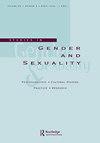精神分析的变态:女巫、婊子和荡妇
Q3 Social Sciences
引用次数: 1
摘要
摘要变态被认为是精神分析精神病理学的三个主要结构之一,它是一个相当广泛的类别,通常基于所谓的异常行为:非霸权性行为、反社会犯罪或无法控制的冲动。这个术语的使用所涉及的认识论和政治争议提出了几个问题,其中之一是这个概念的道德范围,这个概念是由19世纪的精神病学创造的,并被传递给主流精神分析。本文旨在探讨性自然化在变态心理分析理论中所扮演的角色,以及这一类别的广泛性。为了解决这些问题,作者考虑了精神分析精神病理学中目前对变态的一些定义,试图质疑他们的一些理论假设。当将这些有争议的定义与弗洛伊德对变态的多层面考虑相结合时,作者发现,与其说弗洛伊德接受了这个范畴,不如说他颠覆了它。因此,从性别和性的解构来看,遵循福柯对“身体和快乐”的禁令,作者试图展示精神分析应该如何保持反常,以延续弗洛伊德对变态的颠覆性方法。本文章由计算机程序翻译,如有差异,请以英文原文为准。
Psychoanalysis’s Perversions: Witches, Bitches, and Sluts
ABSTRACT Considered one of the three main structures of psychoanalytic psychopathology, perversion is quite an extensive category that is often based on behavior that is supposedly abnormal: nonhegemonic sexual practices and antisocial offenses or uncontrollable impulses. The epistemological and political controversy involved in the use of this term raises several questions, one of which is the moral reach of this notion coined by 19th-century psychiatry and passed on to mainstream psychoanalysis. This article aims to tackle the role sexuality naturalization plays in the psychoanalytic theorization of perversions, but also the extensiveness of this category. To address these questions, the author considers some current definitions of perversions in psychoanalytic psychopathology, to try to question some of their theoretical assumptions. When confronting these controversial definitions with Freud’s multilayered considerations about perversions, the author finds that it appears that Freud did not so much take up the category as he subverted it. Hence, in light of gender and sexuality deconstruction, and following Foucault’s injunction to “bodies and pleasures,” the author tries to show how psychoanalysis should remain perverse, in order to perpetuate Freud’s subversive approach to perversions.
求助全文
通过发布文献求助,成功后即可免费获取论文全文。
去求助
来源期刊

Studies in Gender and Sexuality
Social Sciences-Gender Studies
CiteScore
0.80
自引率
0.00%
发文量
15
期刊介绍:
Beginning in the final two decades of the 20th century, the study of gender and sexuality has been revived from a variety of directions: the traditions of feminist scholarship, postclassical and postmodern psychoanalytic theory, developmental research, and cultural studies have all contributed to renewed fascination with those powerfully formative aspects of subjectivity that fall within the rubric of "gender" and "sexuality." Clinicians, for their part, have returned to gender and sexuality with heightened sensitivity to the role of these constructs in the treatment situation, including the richly variegated ways in which assumptions about gender and sexuality enter into our understandings of "normality" and "pathology."
 求助内容:
求助内容: 应助结果提醒方式:
应助结果提醒方式:


